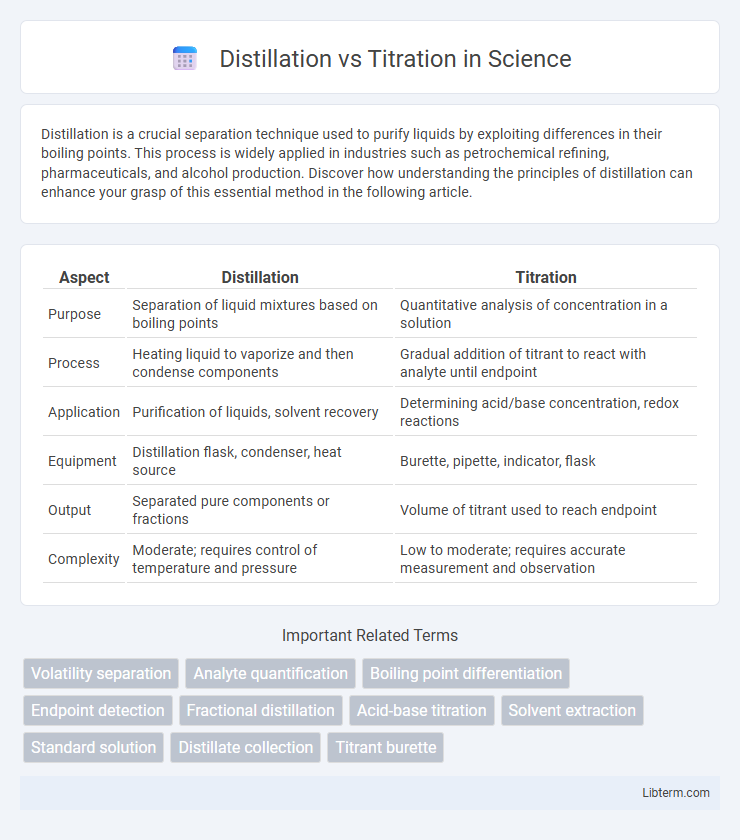Distillation is a crucial separation technique used to purify liquids by exploiting differences in their boiling points. This process is widely applied in industries such as petrochemical refining, pharmaceuticals, and alcohol production. Discover how understanding the principles of distillation can enhance your grasp of this essential method in the following article.
Table of Comparison
| Aspect | Distillation | Titration |
|---|---|---|
| Purpose | Separation of liquid mixtures based on boiling points | Quantitative analysis of concentration in a solution |
| Process | Heating liquid to vaporize and then condense components | Gradual addition of titrant to react with analyte until endpoint |
| Application | Purification of liquids, solvent recovery | Determining acid/base concentration, redox reactions |
| Equipment | Distillation flask, condenser, heat source | Burette, pipette, indicator, flask |
| Output | Separated pure components or fractions | Volume of titrant used to reach endpoint |
| Complexity | Moderate; requires control of temperature and pressure | Low to moderate; requires accurate measurement and observation |
Introduction to Distillation and Titration
Distillation is a separation technique used to isolate components in a liquid mixture based on differences in boiling points, commonly applied in chemistry and industrial processes for purifying liquids or extracting essential oils. Titration is an analytical method that determines the concentration of an unknown solution by reacting it with a solution of known concentration, widely used in quantitative chemical analysis. Both techniques are fundamental in laboratory settings, with distillation focusing on physical separation and titration emphasizing precise chemical measurement.
Defining Distillation: Principles and Processes
Distillation is a separation process based on differences in boiling points of components in a liquid mixture, where the mixture is heated to vaporize the more volatile substances followed by condensation to collect the purified distillate. Key principles include phase change, vapor-liquid equilibrium, and selective condensation, enabling separation of components such as ethanol from water or crude oil fractions. Distillation processes vary from simple batch distillation to continuous fractional distillation, widely used in chemical laboratories, petroleum refining, and alcohol production.
Explaining Titration: Methods and Mechanisms
Titration is a precise analytical technique used to determine the concentration of an unknown solution by gradually adding a titrant of known concentration until the reaction reaches an endpoint, often indicated by a color change. Common methods include acid-base titration, redox titration, complexometric titration, and precipitation titration, each relying on specific chemical reactions to quantify analytes. The underlying mechanism involves stoichiometric neutralization or reaction between the titrant and analyte, detected via indicators, pH meters, or potentiometric sensors for accurate endpoint determination.
Key Equipment Used in Distillation and Titration
Key equipment used in distillation includes a distillation flask, condenser, thermometer, and receiving flask, enabling the separation of liquid mixtures based on boiling points. In titration, essential apparatus comprises a burette, pipette, conical flask, and indicator solution, facilitating precise volume measurement and detection of reaction endpoints. Both techniques rely on specialized glassware to ensure accuracy and efficiency in chemical analysis.
Applications of Distillation in Industry and Research
Distillation is extensively used in the petroleum industry for refining crude oil into valuable fractions such as gasoline, diesel, and kerosene by exploiting differences in boiling points. In chemical research and pharmaceuticals, distillation purifies solvents and separates reaction products, ensuring high purity and yield. The food and beverage sector relies on distillation for producing spirits and essential oils, highlighting its critical role in both industrial and laboratory settings.
Titration Applications Across Various Fields
Titration is a precise analytical technique widely used in chemistry, biology, environmental science, and pharmaceuticals to determine the concentration of an unknown solution by reacting it with a standard solution. Its applications include quality control in manufacturing, assessing water hardness in environmental monitoring, and analyzing blood acidity levels in medical diagnostics. This versatility makes titration an essential tool for accurate quantitative analysis across diverse scientific and industrial fields.
Distillation vs Titration: Major Differences
Distillation separates components based on differences in boiling points, while titration measures concentration through chemical reactions. Distillation is a physical separation process used for purifying liquids, whereas titration is an analytical technique for quantifying solutes. Distillation involves phase changes and condensation, whereas titration involves precise volume measurements and indicator usage.
Advantages and Limitations of Distillation
Distillation offers the advantage of efficiently separating components based on differences in boiling points, making it ideal for purifying liquids and recovering solvents in chemical processes. However, its limitations include high energy consumption and impracticality for separating components with very close boiling points or heat-sensitive compounds. Compared to titration, distillation does not provide quantitative concentration data but excels in physical separation and purification tasks.
Pros and Cons of Titration Techniques
Titration techniques offer precise quantification of analyte concentration with high accuracy and relatively simple laboratory setup, making them ideal for various chemical analyses. However, titration requires skilled operators to avoid errors from inconsistent endpoint detection and can be time-consuming for complex mixtures. Compared to distillation, titration is less effective for separating components but excels in identifying concentrations without extensive apparatus.
Choosing Between Distillation and Titration: Factors to Consider
Choosing between distillation and titration depends on the specific analytical goals and sample characteristics. Distillation is ideal for separating components based on boiling points, commonly used for purifying liquids or isolating volatile compounds. Titration is preferred for quantifying the concentration of a specific analyte in a solution through a controlled chemical reaction, suitable for precise stoichiometric analysis.
Distillation Infographic

 libterm.com
libterm.com